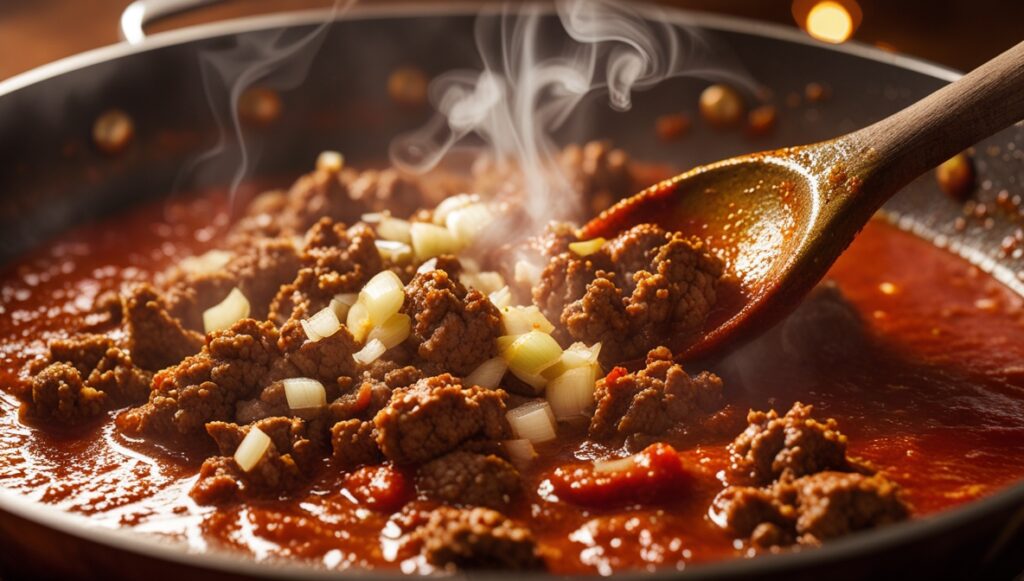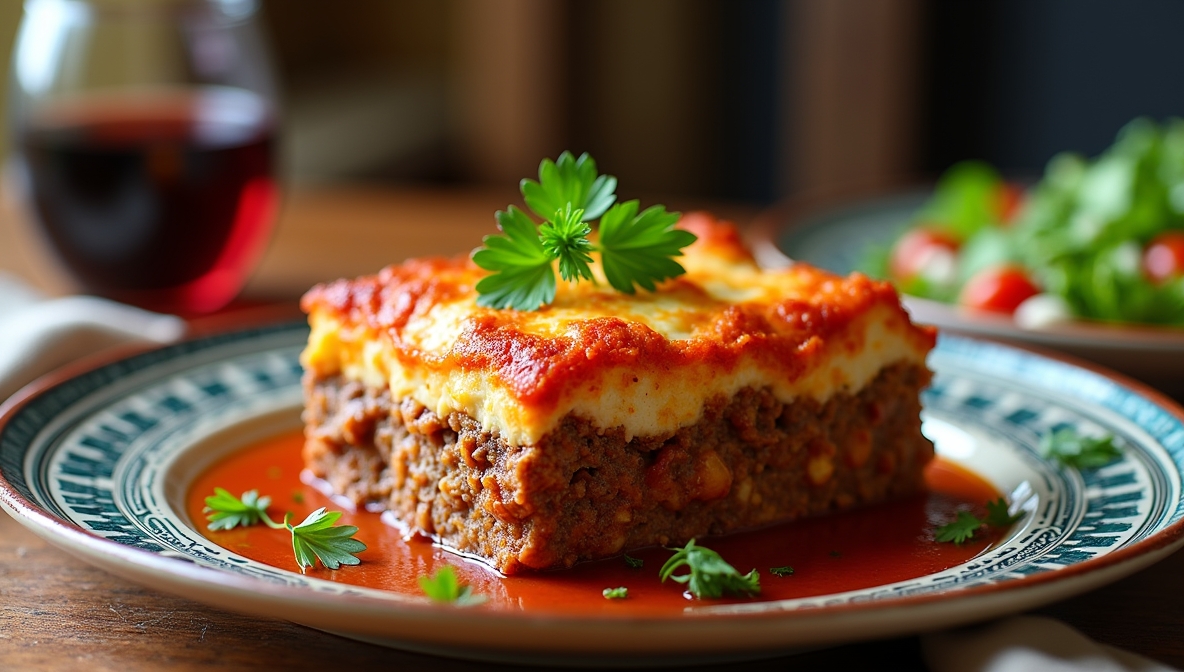Introduction
Moussaka is one of Greece’s most beloved and iconic dishes, known for its rich layers of eggplant, minced meat, and creamy béchamel sauce. This hearty and flavorful dish embodies the essence of Greek comfort food, often served in homes and traditional tavernas. Its deep, savory taste and satisfying texture make it a staple in Greek cuisine and a favorite among travelers exploring the country’s culinary delights.


History & Cultural Significance
Moussaka’s origins trace back to the Middle East and the Ottoman Empire, but it was popularized in Greece by the renowned Greek chef Nikolaos Tselementes in the early 20th century. Tselementes introduced the French-inspired béchamel sauce, transforming Moussaka into the dish we recognize today. Traditionally, it is prepared during festive gatherings and family meals, symbolizing Greek hospitality and culinary excellence.
Ingredients & Regional Variations
Key Ingredients:
Eggplants (aubergines)
Ground lamb or beef
Tomatoes, onions, garlic
Olive oil and spices (cinnamon, nutmeg, oregano)
Béchamel sauce (milk, butter, flour, eggs, and cheese)
Potatoes (optional)
Regional Variations:
Classic Greek Moussaka – Layers of eggplant, minced meat, and béchamel.
Vegetarian Moussaka – Uses lentils or mushrooms instead of meat.
Cypriot Moussaka – Includes zucchini and potatoes.
Modern Adaptations – Some versions use vegan béchamel or gluten-free ingredients.
Cooking Process & Difficulty Level

Moussaka may sound complicated, but it’s actually quite manageable for most home cooks, especially those with some experience in layering dishes. Here’s a brief cooking guide:
Difficulty Level:
Intermediate. It requires some preparation, but with a little patience, you’ll be rewarded with a hearty, flavorful meal.
Step-by-Step Cooking Guide:
Prepare the Eggplant: Slice the eggplant and salt it to remove bitterness. Grill or fry the slices until golden.
Cook the Meat Sauce: Sauté onions and garlic, then add ground meat and cook until browned. Add tomatoes, spices, and simmer to create a flavorful sauce.
Make the Béchamel Sauce: Melt butter, whisk in flour to create a roux, then slowly add milk and stir until thickened. Stir in egg yolks and cheese to create a creamy sauce.
Assemble the Layers: In a baking dish, layer the eggplant, meat sauce, and béchamel sauce, finishing with a generous layer of béchamel on top.
Bake: Bake the Moussaka in the oven until golden and bubbling.
Where to Eat Moussaka in Greece
While This Dish can be found in almost every Greek home and restaurant, here are some top places to enjoy the dish:
Kuzina (Athens): This contemporary Greek restaurant serves up a refined version of Moussaka, combining tradition with modern twists.
Ouzeri tou Laki (Mykonos): A hidden gem, this local favorite offers authentic Greek comfort food, including a mouthwatering Moussaka.
Taverna To Steki (Santorini): Known for its traditional home-style cooking, this taverna is famous for its flavorful Moussaka and warm hospitality.
For a more high-end experience, check out Folly’s (Athens), a Michelin-starred restaurant offering a gourmet version of this classic dish.
Pairing with Drinks & Side Dishes
Drinks:
Moussaka pairs wonderfully with a variety of beverages:
Greek Wine: Try a glass of Agiorgitiko or Assyrtiko, two of Greece’s most popular wines.
Ouzo: A traditional Greek anise-flavored spirit that can complement the richness of Moussaka.
Greek Coffee: For dessert, enjoy a cup of strong Greek coffee to balance the flavors.
Side Dishes:
Moussaka is often served with a simple side salad made with tomatoes, cucumbers, and feta cheese, or some fresh pita bread to soak up the sauce.
Fun Facts & Lesser-Known Trivia
Celebrity Endorsement: Moussaka has gained worldwide recognition, with celebrities like Julia Roberts mentioning it as one of their favorite Greek dishes.
Middle Eastern Roots: While Moussaka is widely considered Greek, its origins can be traced back to the Middle East. It is often compared to dishes like Imam Bayildi and Baba Ganoush, both of which feature eggplant as the main ingredient.
Health Benefits & Nutrition
Moussaka is a rich, comforting dish, but it offers some nutritional benefits too:
Protein: The ground meat in Moussaka provides a good source of protein.
Fiber: Eggplant is a great source of dietary fiber.
Healthy Fats: The olive oil used in cooking adds healthy monounsaturated fats.
For those with dietary restrictions, there are vegan and gluten-free versions available, where the meat can be substituted with lentils or vegetables, and the béchamel sauce is made with plant-based milk and a gluten-free flour blend.
How to Cook It at Home (Best Moussaka Recipe)
Ingredients:
2 large eggplants
1 lb ground beef or lamb
1 onion, chopped
2 cloves garlic, minced
2 tomatoes, chopped
1 cup milk
1/4 cup flour
2 tbsp butter
2 egg yolks1/2 cup grated cheese (parmesan or kefalotyri)
Olive oil, salt, and pepper
Method:
Prepare the Eggplant: Slice the eggplants, sprinkle with salt, and let them sit for 30 minutes. Rinse and fry until golden.
Cook the Meat Sauce: Sauté onions and garlic in olive oil, then add ground meat and cook until browned. Add chopped tomatoes, spices, and simmer for 30 minutes.
Make the Béchamel Sauce: Melt butter, whisk in flour, and gradually add milk. Stir until thickened. Add egg yolks and cheese.
Assemble: In a baking dish, layer the eggplant, meat sauce, and béchamel sauce.
Bake: Bake at 375°F (190°C) for 45 minutes until golden brown.
Tips for Enhancing Flavor:
Add a pinch of cinnamon to the meat sauce for an authentic Greek touch.
For extra richness, top with more cheese before baking.
Global Influence & Fusion Cuisine
Moussaka has inspired many variations around the world. In the United States and other parts of Europe, you’ll find recipes that replace the eggplant with other vegetables, or use a combination of meats. The dish has also inspired creative fusion cuisine in countries like Australia, where it’s combined with different Mediterranean flavors or served as part of a broader Greek-inspired menu.
Comparison with Similar Dishes
Moussaka shares similarities with other famous layered dishes:
Lasagna (Italy): Both feature layers of meat and cheese, but Moussaka replaces pasta with eggplant and uses béchamel instead of ricotta.
Casseroles (Various Countries): While casseroles might have different ingredients, Moussaka’s layering and creamy sauce make it a unique Greek take on the dish.

